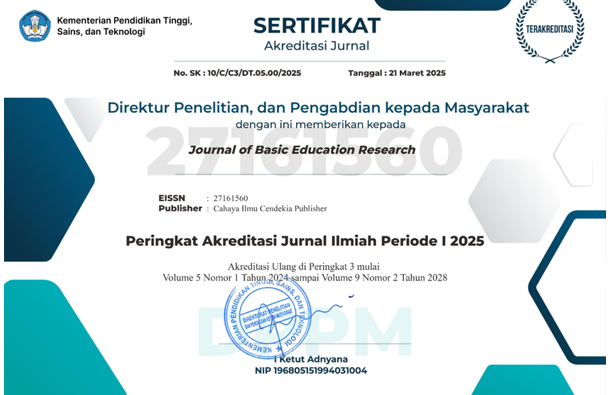Reading Literacy Assessment in Philippine Basic Education: A Cross-Sectional, School-Based Phil-IRI Study
Abstract
Purpose of the study: To examine whether age, sex, and grade level are associated with Philippine Informal Reading Inventory (Phil-IRI) performance in junior high school.
Methodology: Cross-sectional, ex post facto analysis of n = 200 Grade 7–10 students (SY 2024–2025). Phil-IRI (Filipino) post-test scores were compared using Mann–Whitney U (sex) and Kruskal–Wallis H (age bands; grade levels), α = .05.
Main Findings: Sex was associated with Phil-IRI scores: females outperformed males (Mdn = 26 vs 19; p < .001). No differences were found by age (p = .087) or grade (p = .513). Descriptives showed a small, lower-performing oldest age band and non-monotonic medians across grades, indicating variation occurs mainly within rather than between grades.
Novelty/Originality of this study: Phil-IRI outcomes in this cohort relate to sex, not to age or grade. Schools should prioritize within-grade, profile-based supports using Phil-IRI decision levels and implement boy-responsive engagement, while monitoring older learners who remain below independence.
References
T. Kheang, P. Chin, and S. Em, “Reading motivation to promote students’ reading comprehension: A review,” International Journal of Languages and Culture, vol. 4, no. 1, pp. 1–8, 2024, doi: 10.51483/IJLC.4.1.2024.1-8.
K. Mastrothanasis, M. Kladaki, and A. Andreou, “A systematic review and meta-analysis of the Readers’ Theatre impact on the development of reading skills,” International Journal of Educational Research Open, vol. 4, Art. no. 100243, 2023, doi: 10.1016/j.ijedro.2023.100243.
OECD, PISA 2018 Results (Volume I): What Students Know and Can Do. Paris, France: OECD Publishing, 2019, doi: 10.1787/5f07c754-en.
OECD, PISA 2022 Results (Volume I): The State of Learning and Equity in Education. Paris, France: OECD Publishing, 2023, doi: 10.1787/83b2b81c-en.
UNESCO Institute for Statistics, “UIS education data browser (minimum proficiency in reading),” Montreal, Canada: UIS, Sept. 2023 release.
DepEd (Philippines), “Policy guidelines on the Administration of the Revised Philippine Informal Reading Inventory (Phil-IRI),” Mar. 26, 2018. [Online]. Accessed: Aug. 15, 2025.
DepEd (Philippines), Philippine Informal Reading Inventory (Phil-IRI) Manual, 2018 ed. Manila, Philippines: DepEd, 2018. [Online]. Accessed: Aug. 20, 2025.
DepEd (Philippines), “DO 70, s. 2011 — guidelines on the utilization of funds for the every child a reader program (ECARP),” 2011. [Online]. Accessed: Aug. 12, 2025.
DepEd (Philippines), “DM 143, s. 2012 — Administration of the philippine informal reading inventory (Phil-IRI) Assessment Tools,” 2012. [Online]. Accessed: Aug. 21, 2025.
DepEd Region VIII (Eastern Visayas), “RM — Administration of the Phil-IRI for Key Stages 2 and 3, SY 2024–2025,” 2024. [Online]. Accessed: Aug. 22, 2025.
Schools Division of Nueva Vizcaya, “DM-CT-2024-447 — Administration of the Philippine informal reading inventory (phil-iri) for key stages 2 and 3, SY 2024–2025,” Nov. 29, 2024.
P. B. Gough and W. E. Tunmer, “Decoding, reading, and reading disability,” Remedial and Special Education, vol. 7, no. 1, pp. 6–10, 1986, doi: 10.1177/074193258600700104.
H. W. Catts, “The simple view of reading: Advancements and false impressions,” Remedial and Special Education, vol. 39, no. 5, pp. 317–323, 2018, doi: 10.1177/0741932518767563.
H. S. Scarborough, “Connecting early language and literacy to later reading (dis)abilities: Evidence, theory, and practice,” in Handbook of Early Literacy Research, vol. 1, S. B. Neuman and D. K. Dickinson, Eds. New York, NY, USA: Guilford, 2001, pp. 97–110.
C. A. Perfetti and J. Stafura, “Word knowledge in a theory of reading comprehension,” Scientific Studies of Reading, vol. 18, no. 1, pp. 22–37, 2014, doi: 10.1080/10888438.2013.827687.
J. S. Eccles and A. Wigfield, “Motivational beliefs, values, and goals,” Annual Review of Psychology, vol. 53, pp. 109–132, 2002, doi: 10.1146/annurev.psych.53.100901.135153.
M. van Hek, C. Buchmann, and G. Kraaykamp, “Educational systems and gender differences in reading: A comparative multilevel analysis,” European Sociological Review, vol. 35, no. 2, pp. 169–186, 2019, doi: 10.1093/esr/jcy054.
C. L. Pagal, J. K. A. Mirafuentes, and Q. C. Ypanto, “School age gender gap in reading comprehension,” Journal of Asian Development, vol. 3, no. 2, pp. 78–102, 2017, doi: 10.5296/jad.v3i2.11079.
J. W. Creswell and J. D. Creswell, Research Design: Qualitative, Quantitative, and Mixed Methods Approaches, 5th ed. Thousand Oaks, CA, USA: SAGE, 2018.
K. A. Levin, “Study design III: Cross-sectional studies,” Evidence-Based Dentistry, vol. 7, pp. 24–25, 2006, doi: 10.1038/sj.ebd.6400375.
M. S. Setia, “Methodology series module 3: Cross-sectional studies,” Indian Journal of Dermatology, vol. 61, no. 3, pp. 261–264, 2016, doi: 10.4103/0019-5154.182410.
F. N. Kerlinger and H. B. Lee, Foundations of Behavioral Research, 4th ed. Fort Worth, TX, USA: Harcourt/Wadsworth (Thomson Learning), 2000.
N. J. Salkind, Ed., Encyclopedia of Research Design. Thousand Oaks, CA, USA: SAGE, 2010.
E. von Elm et al., “The Strengthening the Reporting of Observational Studies in Epidemiology (STROBE) statement: Guidelines for reporting observational studies,” PLoS Medicine, vol. 4, no. 10, e296, 2007, doi: 10.1371/journal.pmed.0040296.
J. H. McDonald, Handbook of Biological Statistics, 3rd ed. Baltimore, MD, USA: Sparky House Publishing, 2014.
A. N. Spichtig, J. P. Pascoe, K. M. Gehsmann, F. Gu, and J. D. Ferrara, “The interaction of silent reading rate, academic vocabulary, and comprehension among students in grades 2–12,” Reading Research Quarterly, vol. 57, no. 3, pp. 1003–1019, 2022, doi: 10.1002/rrq.457.
A. A. Funa and R. A. E. Gabay, “Policy guidelines and recommendations on AI use in teaching and learning: A meta-synthesis study,” Social Sciences & Humanities Open, vol. 11, art. 101221, 2025, doi: 10.1016/j.ssaho.2024.101221.
A. A. Funa, R. A. E. Gabay, and J. D. Ricafort, “Gamification, gameplay, and genetics learning: A meta-analysis,” Jurnal Pendidikan IPA Indonesia, vol. 10, no. 4, pp. 462–473, 2021, doi: 10.15294/jpii.v10i4.32143.
A. A. Funa and R. A. E. Gabay, “Bridging the gap among knowledge, attitudes, and behaviors toward sustainable development through I-STEM-PBL-ESD,” International Journal on Studies in Education (IJonSE), vol. 7, no. 2, pp. 288–303, Apr. 2025, doi: 10.46328/ijonse.317.
A. A. Funa and J. D. Ricafort, “Validation and effectiveness of computer-based gamified instructional material for teaching introductory physics,” International Journal of Sciences: Basic and Applied Research, vol. 47, no. 2, pp. 168–180, 2019.
A. A. Funa, R. A. E. Gabay, K. L. Esdicul, and M. S. Prudente, “Secondary teachers’ and students’ perceptions of distance education in science: Focus on learner-centered, action-oriented, and transformative learning,” Dalat Univ. J. Sci., vol. 13, no. 3, pp. 156–181, 2023, doi: 10.37569/DalatUniversity.13.3.1108.A. A. Funa, “Digital badges as rewards in science education: Students’ perceptions and experiences,” Dalat University Journal of Science, vol. 14, no. 2, pp. 107–127, 2024. doi: 10.37569/DalatUniversity.14.2.1212(2024).
A. A. Funa, “Exploring clinical practice education for student midwives: Hospital and community opportunities and challenges,” Midwifery, vol. 139, p. 104186, 2024. doi: 10.1016/j.midw.2024.104186.
A. A. Funa and R. A. E. Gabay, “Cultural adaptation of predictive processing measures: Insights from the Prediction-Related Experiences Questionnaire (PRE-Q) for the Philippine context,” Asian Journal of Psychiatry, vol. 112, p. 104681, 2025. doi: 10.1016/j.ajp.2025.104681.
J. R. Toste, L. Didion, P. Peng, M. J. Filderman, and A. M. McClelland, “A Meta-Analytic Review of the Relations Between Motivation and Reading Achievement for K–12 Students,” Review of Educational Research, vol. 90, no. 3, pp. 420–456, 2020. doi: 10.3102/0034654320919352.
N. K. Scammacca, G. Roberts, S. Vaughn, and K. K. Stuebing, “A meta-analysis of interventions for struggling readers in grades 4–12: 1980–2011,” Journal of Learning Disabilities, vol. 48, no. 4, pp. 369–390, 2015. doi: 10.1177/0022219413504995.
D. Fuchs, L. S. Fuchs, and D. L. Compton, “Smart RTI: A next-generation approach to multilevel prevention,” Exceptional Children, vol. 78, no. 3, pp. 263–279, 2012. doi: 10.1177/001440291207800301.
What Works Clearinghouse, Providing Reading Interventions for Students in Grades 4–9 (WWC 2022007), Washington, DC: U.S. Department of education, institute of education sciences, 2022. URL: ies.ed.gov/ncee/wwc/practiceguide/29.
J. M. Ramallosa, A. A. Funa, A. T. Geron, R. T. Ibardaloza, and M. S. Prudente, “Meta-analysis on the effectiveness of argument-based learning on students’ conceptual understanding,” in Proc. 13th Int. Conf. on E-Education, E-Business, E-Management and E-Learning (IC4E), Tokyo, Japan, Jan. 14–17, 2022, pp. 315–323, doi: 10.1145/3514262.3514305.
N. L. Mediana, Jr., A. A. Funa, and R. V. Dio, “Effectiveness of inquiry-based learning (IbL) on improving students’ conceptual understanding in science and mathematics: A meta-analysis,” International Journal of Education in Mathematics, Science and Technology, vol. 13, no. 2, pp. 532–552, 2025, doi: 10.46328/ijemst.4769.
Copyright (c) 2025 Aaron Funa, Julie Ann Balisoro, Renz Alvin Gabay

This work is licensed under a Creative Commons Attribution 4.0 International License.
Authors who publish with this journal agree to the following terms:
- Authors retain copyright and acknowledge that the Journal of Basic Education Research is the first publisher licensed under a Creative Commons Attribution 4.0 International License.
- Authors are able to enter into separate, additional contractual arrangements for the non-exclusive distribution of the journal's published version of the work (e.g., post it to an institutional repository or publish it in a book), with an acknowledgment of its initial publication in this journal.
- Authors are permitted and encouraged to post their work online (e.g., in institutional repositories or on their website) prior to and during the submission process, as it can lead to productive exchanges and earlier and greater citation of published work.





.png)


.png)
.png)


















